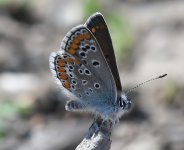I see what you mean. That's the spot I said above had no value for ID. It can be present or absent on any Polyommatine butterfly (the subfamily that includes Aricia, Polyommatus, Agriades, etc), it (its presence) varies with the individual not with species. Actually, on Polyommatine butterflies all spots vary in intensity and presence (and shape), what is constant (approximately) is their relative positions. The most well known case is the icarinus aberration of Common Blue, which may cause (and it does) confusion with Chapman's Blue. Less well known is the case of Chapman's Blue having a spot in the cell area, just as Common Blue does. Hope this helps. Cheers.







